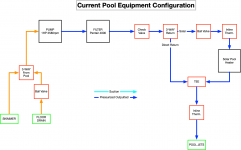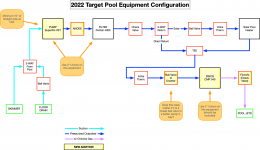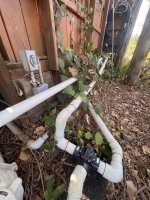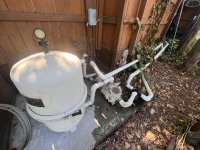Long-time lurker and a huge fan of TFP! Thanks to this collection of characters I've managed to keep my pool crystal clear with minimal work and money for the past 3+ years. You folks are all the best!
So my 1HP single-speed pump is getting very loud, appears to be leaking a bit, and is time for retirement. As an LA City DWP customer, I can get $1k rebate if I have a variable speed pump professional installed, and I figure while I'm in there, I might as well clean up a bunch of garbage from the previous owners and add some other goodies (namely, conversion to SWCG).
However, I have NO IDEA what I'm doing, so looking to get feedback from the peanut gallery here. I am a nerd with lots of home automation stuff already in place, so I'm looking to extend some basic control to the new pump and SWCG (my intent is to use my HA for override control and let something other than the HA maintain the regular pump+SWCG schedule).
SWCG Questions
* I originally spec'd a Pentair IC20 for my SWCG conversion, but the pool installer I spoke with cautioned me against buying any Hayward or Pentail SWCG. He strongly recommended the CMP 540 for easier maintenance and durability (which sadly I have not been able to source the CMP 540, so may go with the CMP 320, which should be plenty). The CMP will make my home-grown automation a little trickier (as I can only do external power on / off with the CMP), but should be a-ok. Thoughts or comments about CMP over Pentair or others?
* I understand why you'd want to put the SWCG after a regular gas-fired pool heater (minimize corrosion), and it seems to reason to put it after the solar heater (minimize any gas collection in the solar cells), but it is unclear if this is needed or not. A call to CMP provided no value on the topic. It would be much easier to put the SWCG before the 3-WAY immediately after the filter, but my hunch is that I should put it after the TEE combining both the direct return and solar heater.
* It looks like I should be able to remove the element of the CMP and just place a cap over the PVC that it sits in to effectively act as a bypass. Does such a thing exist? Is it included with the CMP? Will a 2" PVC cap work (how would it seal)?
Plumbing General
* Was planning to put 2" unions on both the pump and filter, any reason to not do this?
* Any reason to put unions elsewhere?
* There's an existing ball valve before the solar pool heater, was thinking to put one downstream before the SWCG. Any reason to not do this? I'm assuming this is for equipment maintenance.
* If so, should I use the cheaper ball valve (since it will be rarely used) or a more proper Jandy diverter (which I can rebuild)?
* Any reason to sprinkle more check valves or ball valves anywhere else?
Electrons
* My pool is old and likely not bonded, which is bad itself, but also may make an anode even less useful. My plan was to bond the new pump, SWCG, and a new in-line anode. Based on a couple of diagrams I found, the location between the pump and the filter seems to be the best place for the anode. I would have thought to put it after the filter, but [shrug]. Thoughts?
* I there a low-voltage output from the Superflow that I could use to trigger a relay to fire up the CMP whenever the pump is running? I see a voltage output on their pinout, but I suspect that it is always hot since it is intended to be the power source for triggering the various relay speeds.
* For my HA goals, I know I can get pretty far with the Superflo VST (late model) that I spec'd (using the RS-485 interface), but I don't see many options for integrating (read: changing modes, reading feedback?) from the CMP. If there's anything I should be considering, please advise!
* Every now and again I scour the interwebs for some kind of in-line pool chemistry detection, and it seems like there aren't many reasonable solutions. If this has changed, or I'm just missing something, please advise! Would love to have inline chemistry detection that I can hook up to my automation.
I really appreciate you folks looking over my novel-length post here. I expect zero replies but appreciate any insight provided. Thank you in advance. Now, please enjoy my crappy diagrams!
So my 1HP single-speed pump is getting very loud, appears to be leaking a bit, and is time for retirement. As an LA City DWP customer, I can get $1k rebate if I have a variable speed pump professional installed, and I figure while I'm in there, I might as well clean up a bunch of garbage from the previous owners and add some other goodies (namely, conversion to SWCG).
However, I have NO IDEA what I'm doing, so looking to get feedback from the peanut gallery here. I am a nerd with lots of home automation stuff already in place, so I'm looking to extend some basic control to the new pump and SWCG (my intent is to use my HA for override control and let something other than the HA maintain the regular pump+SWCG schedule).
SWCG Questions
* I originally spec'd a Pentair IC20 for my SWCG conversion, but the pool installer I spoke with cautioned me against buying any Hayward or Pentail SWCG. He strongly recommended the CMP 540 for easier maintenance and durability (which sadly I have not been able to source the CMP 540, so may go with the CMP 320, which should be plenty). The CMP will make my home-grown automation a little trickier (as I can only do external power on / off with the CMP), but should be a-ok. Thoughts or comments about CMP over Pentair or others?
* I understand why you'd want to put the SWCG after a regular gas-fired pool heater (minimize corrosion), and it seems to reason to put it after the solar heater (minimize any gas collection in the solar cells), but it is unclear if this is needed or not. A call to CMP provided no value on the topic. It would be much easier to put the SWCG before the 3-WAY immediately after the filter, but my hunch is that I should put it after the TEE combining both the direct return and solar heater.
* It looks like I should be able to remove the element of the CMP and just place a cap over the PVC that it sits in to effectively act as a bypass. Does such a thing exist? Is it included with the CMP? Will a 2" PVC cap work (how would it seal)?
Plumbing General
* Was planning to put 2" unions on both the pump and filter, any reason to not do this?
* Any reason to put unions elsewhere?
* There's an existing ball valve before the solar pool heater, was thinking to put one downstream before the SWCG. Any reason to not do this? I'm assuming this is for equipment maintenance.
* If so, should I use the cheaper ball valve (since it will be rarely used) or a more proper Jandy diverter (which I can rebuild)?
* Any reason to sprinkle more check valves or ball valves anywhere else?
Electrons
* My pool is old and likely not bonded, which is bad itself, but also may make an anode even less useful. My plan was to bond the new pump, SWCG, and a new in-line anode. Based on a couple of diagrams I found, the location between the pump and the filter seems to be the best place for the anode. I would have thought to put it after the filter, but [shrug]. Thoughts?
* I there a low-voltage output from the Superflow that I could use to trigger a relay to fire up the CMP whenever the pump is running? I see a voltage output on their pinout, but I suspect that it is always hot since it is intended to be the power source for triggering the various relay speeds.
* For my HA goals, I know I can get pretty far with the Superflo VST (late model) that I spec'd (using the RS-485 interface), but I don't see many options for integrating (read: changing modes, reading feedback?) from the CMP. If there's anything I should be considering, please advise!
* Every now and again I scour the interwebs for some kind of in-line pool chemistry detection, and it seems like there aren't many reasonable solutions. If this has changed, or I'm just missing something, please advise! Would love to have inline chemistry detection that I can hook up to my automation.
I really appreciate you folks looking over my novel-length post here. I expect zero replies but appreciate any insight provided. Thank you in advance. Now, please enjoy my crappy diagrams!





